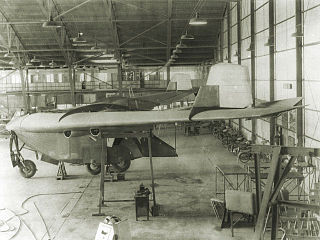Related Research Articles

The DFS 194 was a rocket-powered aircraft designed by Alexander Lippisch at the Deutsche Forschungsanstalt für Segelflug.

The Horten H.IV was a German tailless flying wing glider in which the pilot was to lie in a prone position to reduce the frontal area, and hence drag. It was designed by Reimar and Walter Horten in Göttingen. Four were built between 1941 and 1943. They were flown in a number of unofficial competitions in Germany during World War II. After the war the flying examples were transported to the United Kingdom and the United States where several contest successes were achieved.

The Baynes Bat was an experimental glider of the Second World War, designed by L. E. Baynes. It was used to test the tailless design that he had suggested as a means to convert tanks into temporary gliders so they could be flown into battle.
The Messerschmitt Me 265 was a design project for a Zerstörer, produced by leading German aircraft manufacturer Messerschmitt in World War II.

The General Aircraft GAL.56 was a family of 1940s British experimental tailless swept wing glider designs.

The Fauvel AV.36 was a single-seat tailless glider designed in France in the 1950s by Charles Fauvel. Although the "AV" in AV.36 stands for Aile Volante, it was not a true flying wing: it featured two large fins mounted on stubby tailbooms extending back from the wing's trailing edge, and accommodated the pilot within a stubby fuselage. The aircraft was designed to be quickly disassembled for road transport, with the nose detaching, and the fins able to fold back against the trailing edge of the wing. A refined version with a slightly longer wingspan, the AV.361 was introduced in 1960.

The Loire 70 was a 1930s French long-range maritime reconnaissance flying boat produced by Loire Aviation.

The DINFIA IA 38 was a 1960s Argentine four-engine experimental tailless transport aircraft, designed under the direction of Reimar Horten and based on the German Horten Ho VIII project and built by the DINFIA.

The Granger Archaeopteryx is a British single-engined, tailless parasol monoplane designed and built in the late 1920s by two brothers, R.F.T. and R.J.T. Granger. The sole example built is currently under restoration for flight.

The I.Ae. 34 Clen Antú, sometimes known as the Horten XVa after its designer Reimar Horten, was a two-seat tailless glider built in Argentina. Two single-seat variants competed unsuccessfully in the 1952 World Gliding Championships.

The I.Ae.41 Urubú was a two-seat flying wing tailless glider, built in Argentina by the Fábrica Militar de Aviones (FMA) in the 1950s.
The Nike PUL 9 is an Argentine experimental tailless aircraft powered by a Rotax 447 engine.
The Pop's Props Cloudster is a single seat, open-cockpit, parasol wing, single-engine monoplane, that was first flown in 1995. The aircraft was produced by Pop's Props of Cooksville, Illinois and made available as plans or in kit form. The company is no longer in business and kit production has been transferred to Simplex Aeroplanes of Old Saybrook, Connecticut.

The DFS 193 was a planned experimental German aircraft of the 1930s planned by Deutsche Forschungsanstalt für Segelflug (DFS). Designed by Professor Alexander Lippisch and a DFS employee named Roth, it resembled Lippisch's Storch IX and the Gotha Go 147.
The NRC tailless glider, also called the NRL tailless glider, was a two-seat tailless research glider designed by the National Research Council of Canada and built by the National Research Laboratories, at the instigation of G.T.R. Hill who had previously designed the British Westland-Hill Pterodactyl series of tailless aircraft.

The Blohm & Voss P.208 was a design project for a tailless swept-wing propeller-powered interceptor designed by the German company Blohm & Voss towards the end of the Second World War.
The Carmier Simplex 10 hp was a French tailless, low power, single seat aircraft built in 1923 for a contest arranged by a Paris newspaper. Only one is known to have been completed and its career was brief.

The Kalinin K-12 was a proof-of-concept aircraft developed by the Kalinin Design Bureau in the 1930s.

The Horten H.VII was a flying wing fighter-trainer aircraft designed by the Horten brothers during World War II.

The Horten H.XIII was an experimental flying wing aircraft designed by the Horten brothers during World War II.
References
- ↑ Weyl, A. R. (A.F.R.Ae.S) (1944). "Tailless Aircraft and Flying Wings: A Study of Their Evolution and Their Problems". Aircraft Engineering and Aerospace Technology. 16 (12): 340–360. doi:10.1108/eb031199.
- ↑ Taylor, Michael (28 April 2001). The World's Strangest Aircraft: A Collection of Weird and Wonderful Flying Machines. MetroBooks. ISBN 978-1586632120.
- ↑ "Carmier-Arnoux Simplex". Avaifrance.com. Retrieved 8 February 2019.